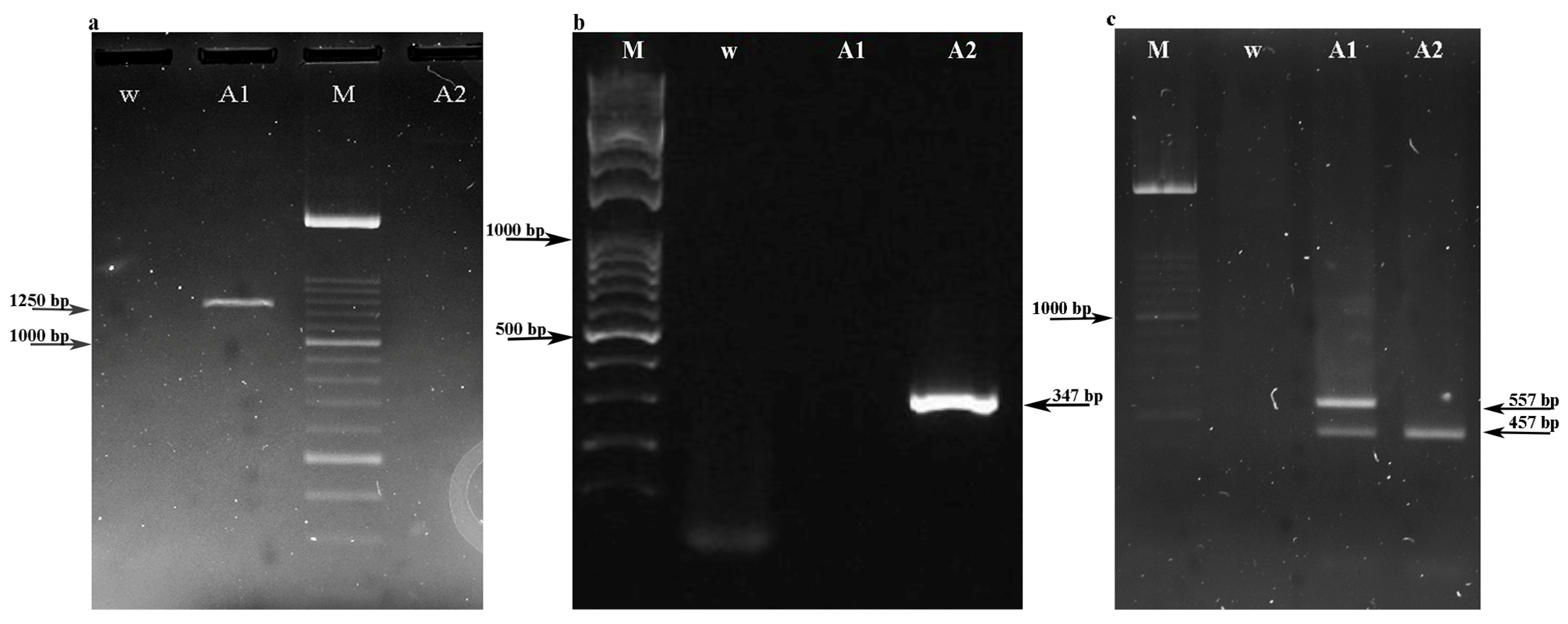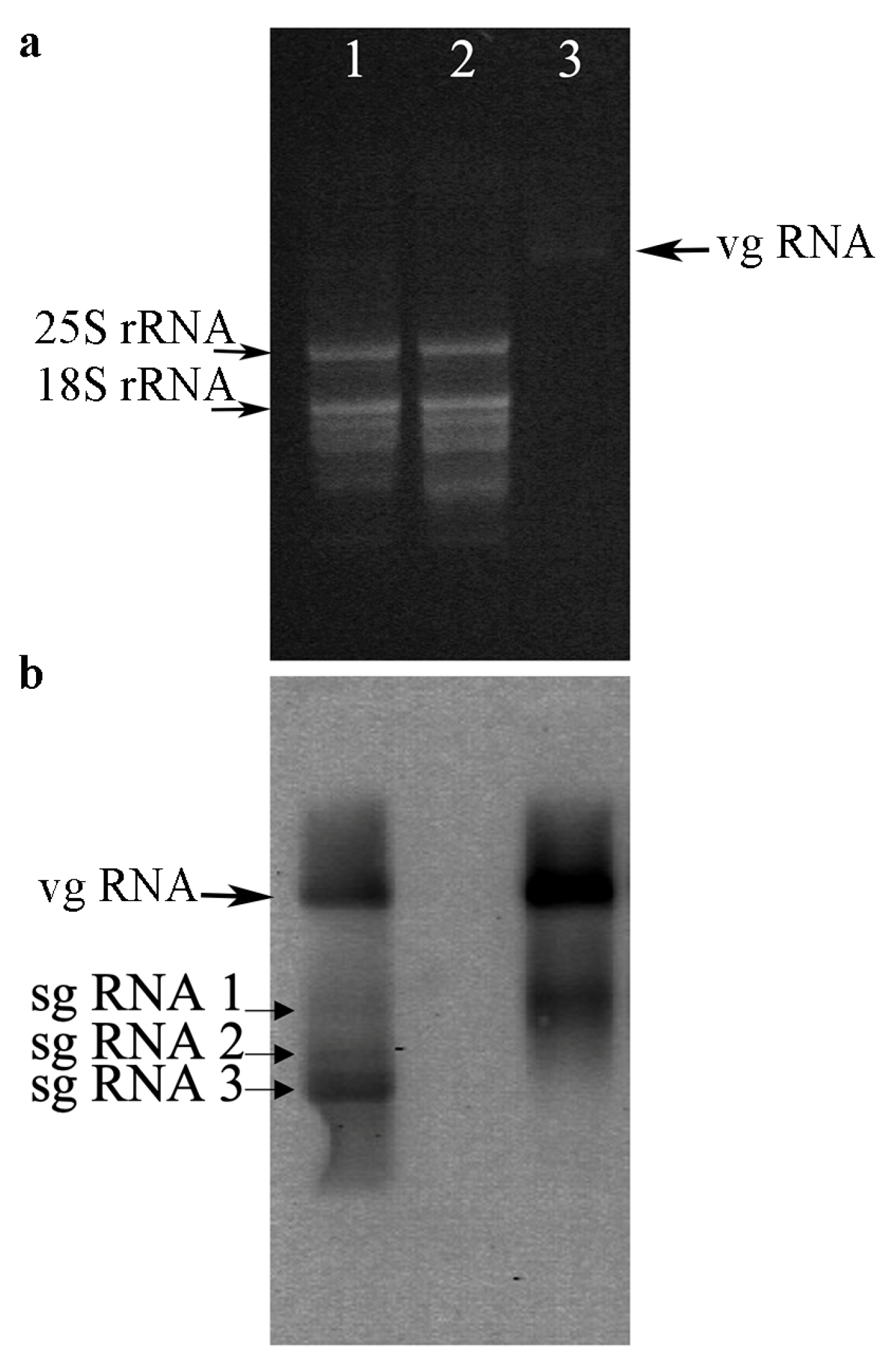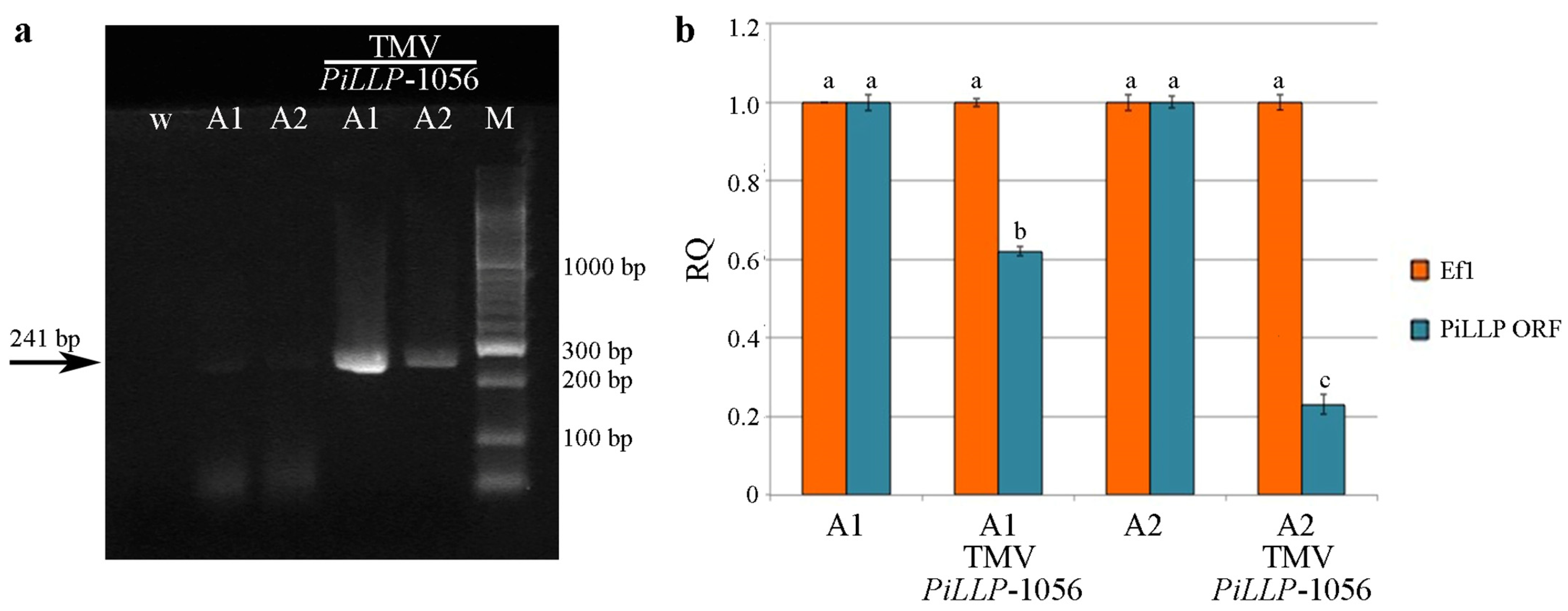Virus-Induced Silencing of a Sequence Coding for Loricrin-like Protein in Phytophthora infestans upon Infection of a Recombinant Vector Based on Tobacco Mosaic Virus
Abstract
:1. Introduction
2. Materials and Methods
2.1. P. infestans Mating Types and Culture Conditions
2.2. TMV-PiLLP-1056 Vector Construction
2.3. Plant Inoculation
2.4. Infection in P. infestans
2.5. Pathogenicity Test
3. Results and Discussion
3.1. P. infestans Mating Types Identification
3.2. Infectivity in Tobacco Plants
3.3. Infectivity in P. infestans
4. Conclusions
Supplementary Materials
Author Contributions
Funding
Data Availability Statement
Acknowledgments
Conflicts of Interest
References
- Kamoun, S.; Furzer, O.; Jones, J.D.; Judelson, H.S.; Ali, G.S.; Dalio, R.J.; Roy, S.G.; Schena, L.; Zambounis, A.; Panabières, F. The Top 10 Oomycete Pathogens in Molecular Plant Pathology. Mol. Plant Pathol. 2015, 16, 413–434. [Google Scholar]
- Luan, Y.; Cui, J.; Li, J.; Jiang, N.; Liu, P.; Meng, J. Effective Enhancement of Resistance to Phytophthora infestans by Overexpression of MiR172a and b in Solanum lycopersicum. Planta 2018, 247, 127–138. [Google Scholar] [CrossRef]
- Fry, W.E.; Birch, P.R.J.; Judelson, H.S.; Grünwald, N.J.; Danies, G.; Everts, K.L.; Gevens, A.J.; Gugino, B.K.; Johnson, D.A.; Johnson, S.B. Five Reasons to Consider Phytophthora infestans a Reemerging Pathogen. Phytopathology 2015, 105, 966–981. [Google Scholar] [CrossRef] [Green Version]
- Whisson, S.C.; Vetukuri, R.R.; Avrova, A.O.; Dixelius, C. Can Silencing of Transposons Contribute to Variation in Effector Gene Expression in Phytophthora infestans? Mob. Genet. Elem. 2012, 2, 110–114. [Google Scholar]
- Zuluaga, A.P.; Vega-Arreguín, J.C.; Fei, Z.; Matas, A.J.; Patev, S.; Fry, W.E.; Rose, J.K. Analysis of the Tomato Leaf Transcriptome during Successive Hemibiotrophic Stages of a Compatible Interaction with the Oomycete Pathogen Phytophthora infestans. Mol. Plant Pathol. 2016, 17, 42–54. [Google Scholar] [CrossRef]
- Whisson, S.C.; Boevink, P.C.; Moleleki, L.; Avrova, A.O.; Morales, J.G.; Gilroy, E.M.; Armstrong, M.R.; Grouffaud, S.; Van West, P.; Chapman, S. A Translocation Signal for Delivery of Oomycete Effector Proteins into Host Plant Cells. Nature 2007, 450, 115–118. [Google Scholar]
- Schornack, S.; van Damme, M.; Bozkurt, T.O.; Cano, L.M.; Smoker, M.; Thines, M.; Gaulin, E.; Kamoun, S.; Huitema, E. Ancient Class of Translocated Oomycete Effectors Targets the Host Nucleus. Proc. Natl. Acad. Sci. USA 2010, 107, 17421–17426. [Google Scholar] [CrossRef] [Green Version]
- Boevink, P.C.; McLellan, H.; Gilroy, E.M.; Naqvi, S.; He, Q.; Yang, L.; Wang, X.; Turnbull, D.; Armstrong, M.R.; Tian, Z. Oomycetes Seek Help from the Plant: Phytophthora infestans Effectors Target Host Susceptibility Factors. Mol. Plant 2016, 9, 636–638. [Google Scholar] [CrossRef] [Green Version]
- Lo Presti, L.; Lanver, D.; Schweizer, G.; Tanaka, S.; Liang, L.; Tollot, M.; Zuccaro, A.; Reissmann, S.; Kahmann, R. Fungal Effectors and Plant Susceptibility. Annu. Rev. Plant Biol. 2015, 66, 513–545. [Google Scholar]
- Tyler, B.M.; Tripathy, S.; Zhang, X.; Dehal, P.; Jiang, R.H.; Aerts, A.; Arredondo, F.D.; Baxter, L.; Bensasson, D.; Beynon, J.L. Phytophthora Genome Sequences Uncover Evolutionary Origins and Mechanisms of Pathogenesis. Science 2006, 313, 1261–1266. [Google Scholar] [CrossRef] [Green Version]
- Haas, B.J.; Kamoun, S.; Zody, M.C.; Jiang, R.H.; Handsaker, R.E.; Cano, L.M.; Grabherr, M.; Kodira, C.D.; Raffaele, S.; Torto-Alalibo, T. Genome Sequence and Analysis of the Irish Potato Famine Pathogen Phytophthora infestans. Nature 2009, 461, 393–398. [Google Scholar]
- Jiang, R.H.; Tyler, B.M. Mechanisms and Evolution of Virulence in Oomycetes. Annu. Rev. Phytopathol. 2012, 50, 295–318. [Google Scholar] [CrossRef]
- Cooke, D.E.; Cano, L.M.; Raffaele, S.; Bain, R.A.; Cooke, L.R.; Etherington, G.J.; Deahl, K.L.; Farrer, R.A.; Gilroy, E.M.; Goss, E.M. Genome Analyses of an Aggressive and Invasive Lineage of the Irish Potato Famine Pathogen. PLoS Pathog. 2012, 8, e1002940. [Google Scholar] [CrossRef]
- Kim, K.-J.; Eom, S.-H.; Lee, S.-P.; Jung, H.-S.; Kamoun, S.; Lee, Y.S. A Genetic Marker Associated with the A1 Mating Type Locus in Phytophthora infestans. J. Microbiol. Biotechnol. 2005, 15, 502–509. [Google Scholar]
- Hashemi, M.; Tabet, D.; Sandroni, M.; Benavent-Celma, C.; Seematti, J.; Andersen, C.B.; Grenville-Briggs, L.J. The Hunt for Sustainable Biocontrol of Oomycete Plant Pathogens, a Case Study of Phytophthora infestans. Fungal Biol. Rev. 2022, 40, 53–69. [Google Scholar]
- Labarile, R.; Farinola, G.M.; Varsalona, M.; Italiano, F.; Buscemi, G.; Trotta, M.; Grattieri, M. Halotolerance of Rhodobacter sphaeroides for Saline and Hypersaline Wastewater Bioremediation. In Proceedings of the 2021 International Workshop on Metrology for the Sea; Learning to Measure Sea Health Parameters (MetroSea), Reggio Calabria, Italy, 4–6 October 2021; pp. 37–42. [Google Scholar]
- Grattieri, M.; Labarile, R.; Buscemi, G.; Trotta, M. The Periodic Table of Photosynthetic Purple Non-Sulfur Bacteria: Intact Cell-Metal Ions Interactions. Photochem. Photobiol. Sci. 2022, 21, 101–111. [Google Scholar] [PubMed]
- Buscemi, G.; Labarile, R.; Farinola, G.M.; Trotta, M. Enhancing Photosynthesis in Organic Biological Hybrid Complexes. In Photochemistry; Royal Society of Chemistry: Cambridge, UK, 2021; pp. 385–410. [Google Scholar]
- Buscemi, G.; Vona, D.; Stufano, P.; Labarile, R.; Cosma, P.; Agostiano, A.; Trotta, M.; Farinola, G.M.; Grattieri, M. Bio-Inspired Redox-Adhesive Polydopamine Matrix for Intact Bacteria Biohybrid Photoanodes. ACS Appl. Mater. Interfaces 2022, 14, 26631–26641. [Google Scholar] [PubMed]
- Su, P.; Tan, X.; Li, C.; Zhang, D.; Cheng, J.; Zhang, S.; Zhou, X.; Yan, Q.; Peng, J.; Zhang, Z.; et al. Photosynthetic bacterium Rhodopseudomonas palustris GJ-22 induces systemic resistance against viruses. Microb Biotechnol. 2017, 3, 612–624. [Google Scholar] [CrossRef] [PubMed]
- Zhang, X.; Li, X.; Zhang, Y.; Chen, Y.; Tan, X.; Su, P.; Zhang, D.; Liu, Y. Integrated Control of Potato Late Blight with a Combination of the Photosynthetic Bacterium Rhodopseudomonas palustris Strain GJ-22 and Fungicides. BioControl 2020, 65, 635–645. [Google Scholar]
- Whisson, S.C.; Avrova, A.O.; Grenville Briggs, L.J.; van West, P. Mechanisms and Application of Gene Silencing in Oomycetes. In Oomycete Genetics and Genomics; John Wiley & Sons, Ltd.: Hoboken, NJ, USA, 2009; pp. 493–515. ISBN 978-0-470-47589-8. [Google Scholar]
- Jahan, S.N.; Åsman, A.K.; Corcoran, P.; Fogelqvist, J.; Vetukuri, R.R.; Dixelius, C. Plant-Mediated Gene Silencing Restricts Growth of the Potato Late Blight Pathogen Phytophthora infestans. J. Exp. Bot. 2015, 66, 2785–2794. [Google Scholar]
- Duo, J.; Tian, Z.; Liu, J.; Vleeshouwers, V.G.; Shi, X.; Xie, C. Functional Analysis of Potato Genes Involved in Quantitative Resistance to Phytophthora infestans. Mol. Biol. Rep. 2013, 40, 957–967. [Google Scholar]
- Cao, X.; Liu, J.; Pang, J.; Kondo, H.; Chi, S.; Zhang, J.; Sun, L.; Andika, I.B. Common but Nonpersistent Acquisitions of Plant Viruses by Plant-Associated Fungi. Viruses 2022, 14, 2279. [Google Scholar] [CrossRef] [PubMed]
- Mascia, T.; Vučurović, A.; Minutillo, S.A.; Nigro, F.; Labarile, R.; Savoia, M.A.; Palukaitis, P.; Gallitelli, D. Infection of Colletotrichum acutatum and Phytophthora infestans by Taxonomically Different Plant Viruses. Eur. J. Plant Pathol. 2019, 153, 1001–1017. [Google Scholar]
- Mascia, T.; Labarile, R.; Doohan, F.; Gallitelli, D. Tobacco Mosaic Virus Infection Triggers an RNAi-Based Response in Phytophthora infestans. Sci. Rep. 2019, 9, 2657. [Google Scholar]
- Mascia, T.; Nigro, F.; Abdallah, A.; Ferrara, M.; De Stradis, A.; Faedda, R.; Palukaitis, P.; Gallitelli, D. Gene Silencing and Gene Expression in Phytopathogenic Fungi Using a Plant Virus Vector. Proc. Natl. Acad. Sci. USA 2014, 111, 4291–4296. [Google Scholar] [CrossRef] [Green Version]
- Feng, H.; Wan, C.; Zhang, Z.; Chen, H.; Li, Z.; Jiang, H.; Yin, M.; Dong, S.; Dou, D.; Wang, Y. Specific Interaction of an RNA-Binding Protein with the 3′-UTR of Its Target MRNA Is Critical to Oomycete Sexual Reproduction. PLoS Pathog. 2021, 17, e1010001. [Google Scholar]
- Situ, J.; Xi, P.; Lin, L.; Huang, W.; Song, Y.; Jiang, Z.; Kong, G. Signal and Regulatory Mechanisms Involved in Spore Development of Phytophthora and Peronophythora. Front. Microbiol. 2022, 13, 984672. [Google Scholar] [PubMed]
- Guo, T.; Wang, X.-W.; Shan, K.; Sun, W.; Guo, L.-Y. The Loricrin-like Protein (LLP) of Phytophthora infestans Is Required for Oospore Formation and Plant Infection. Front. Plant Sci. 2017, 8, 142. [Google Scholar]
- Creager, A.N.; Scholthof, K.-B.G.; Citovsky, V.; Scholthof, H.B. Tobacco Mosaic Virus: Pioneering Research for a Century. Plant Cell 1999, 11, 301–308. [Google Scholar] [CrossRef] [Green Version]
- Shivprasad, S.; Pogue, G.P.; Lewandowski, D.J.; Hidalgo, J.; Donson, J.; Grill, L.K.; Dawson, W.O. Heterologous Sequences Greatly Affect Foreign Gene Expression in Tobacco Mosaic Virus-Based Vectors. Virology 1999, 255, 312–323. [Google Scholar] [CrossRef] [Green Version]
- Wright, K.M.; Cruz, S.S. Life at the Edge-Imaging the Hypersensitive Response Induced by TMV. Annu. Rep. Scott. Crop Res. Inst. 2000, 136–139. [Google Scholar]
- Rabindran, S.; Dawson, W.O. Assessment of Recombinants That Arise from the Use of a TMV-Based Transient Expression Vector. Virology 2001, 284, 182–189. [Google Scholar] [CrossRef] [Green Version]
- De Vrieze, M.; Germanier, F.; Vuille, N.; Weisskopf, L. Combining Different Potato-Associated Pseudomonas Strains for Improved Biocontrol of Phytophthora infestans. Front. Microbiol. 2018, 9, 2573. [Google Scholar] [CrossRef]
- Judelson, H.S. Genetic and Physical Variability at the Mating Type Locus of the Oomycete, Phytophthora infestans. Genetics 1996, 144, 1005–1013. [Google Scholar] [CrossRef]
- Kim, K.-J.; Lee, Y.-S. Genetic DNA Marker for A2 Mating Type in Phytophthora infestans. J. Microbiol. 2002, 40, 254–259. [Google Scholar]
- Judelson, H.S.; Spielman, L.J.; Shattock, R.C. Genetic Mapping and Non-Mendelian Segregation of Mating Type Loci in the Oomycete, Phytophthora infestans. Genetics 1995, 141, 503–512. [Google Scholar] [CrossRef] [PubMed]
- Mazáková, J.; Táborský, V.; Zouhar, M.; Ryšánek, P.; Hausvater, E.; Doležal, P. Occurrence and distribution of mating types A1 and A2 of Phytophthora infestans (Mont.) de Bary in the Czech Republic. Plant Protect. Sci. 2006, 42, 41–48. [Google Scholar] [CrossRef] [Green Version]
- Canto, T.; Palukaitis, P. Novel N Gene-Associated, Temperature-Independent Resistance to the Movement of Tobacco Mosaic Virus Vectors Neutralized by a Cucumber Mosaic Virus RNA1 Transgene. J. Virol. 2002, 76, 12908–12916. [Google Scholar] [CrossRef] [Green Version]
- Lot, H. Contribution a l’etude Du Virus de La Mosaique Du Com-Comber (CMV). I. Method de Purification Rapide Du Virus. Ann. Phytopathol. 1972, 4, 25–38. [Google Scholar]
- Qi, J.; Asano, T.; Jinno, M.; Matsui, K.; Atsumi, K.; Sakagami, Y.; Ojika, M. Characterization of a Phytophthora Mating Hormone. Science 2005, 309, 1828. [Google Scholar] [CrossRef] [Green Version]
- Tomura, T.; Molli, S.D.; Murata, R.; Ojika, M. Universality of the Phytophthora Mating Hormones and Diversity of Their Production Profile. Sci. Rep. 2017, 7, 5007. [Google Scholar] [CrossRef] [PubMed] [Green Version]
- Cariddi, C.; Mincuzzi, A.; Schena, L.; Ippolito, A.; Sanzani, S.M. First Report of Collar and Root Rot Caused by Phytophthora nicotianae on Lycium barbarum. J. Plant Pathol. 2018, 100, 361. [Google Scholar] [CrossRef] [Green Version]
- Barchenger, D.W.; Lamour, K.H.; Bosland, P.W. Challenges and Strategies for Breeding Resistance in Capsicum annuum to the Multifarious Pathogen, Phytophthora capsici. Front. Plant Sci. 2018, 9, 628. [Google Scholar] [CrossRef] [Green Version]
- Vannini, A.; Vettraino, A. Phytophthora cambivora. For. Phytophthoras 2011, 1. [Google Scholar] [CrossRef]
- Leesutthiphonchai, W.; Vu, A.L.; Ah-Fong, A.M.; Judelson, H.S. How does Phytophthora infestans evade control efforts? Modern insight into the late blight disease. Phytopathology 2018, 108, 916–924. [Google Scholar] [CrossRef] [Green Version]







| Primer Name | Sequence | Size (bp) | Ta | Purpose | Ref. |
|---|---|---|---|---|---|
| S1a S1b | 5′-AGGATTTCAACAA-3′ 5′-TGCTTCCTAAGG-3′ | 1250 | 50 | Mating type identification | [37] |
| PHYB-1 PHYB-2 | 5′GATCGGATTAGTCAGACGAG-3′ 5′-GCGTCTGCAAGGCGCATTTT-3′ | 347 | 59 | Mating type identification | [38] |
| W16-1 W16-2 | 5′-AACACGCACAAGGCATATAAATCTA-3′ 5′-GCGTAATGTAGCGTAACAGCTCTC-3′ | 557 | 61 | Mating type identification | [39,40] |
| 5′UTR for 5′UTR rev | 5′-TCTCCTCGAGTCCTCCTCTCTGCGT-3′ 5′-CGACAATATTCCATAACTGCTAAGGTGGGGCTGTAA-3′ | 201 | 54 | 5′UTR region of PiLLP cloning | This study |
| 3′UTR for 3′UTR rev | 5′-TATGGAATATTGTCGAGTACAGCAACGAGGCTTCGA-3′ 5′-CCCCCTTAATTAAACGACACTTGAAACATCGTGAG-3′ | 126 | 59 | 3′UTR region of PiLLP cloning | |
| 5′UTR for 3′UTR rev | 5′-TCTCCTCGAGTCCTCCTCTCTGCGT-3′ 5′-CCCCCTTAATTAAACGACACTTGAAACATCGTGAG-3′ | 327 | 50 | 5′UTR + 3′UTR of PiLLP fusion PCR | |
| GFP pro CP pro | 5′-CGATGATGATTCGGAGGCTA-3′ 5′-ATCCAAGACACAACCCTTCG-3′ | ~500 | 55 | pTMV-1056 plasmid sequencing | |
| REP for REP rev | 5′-CAGTGCATATCGGCATTGTC-3′ 5′-CGTGACTCCTCTTCCGTCTC-3′ | 241 | 50 | TMV replicase of P. infestans detection | |
| PiEF for PiEF rev | 5′-ACTCCAAGAACGACCCTGCTAAGGCAACC-3′ 5′-TCCGACGGCTCGAGGATGACCATGCAG-3′ | 239 | >60 | Real Time PCR of ef1 of P. infestans | [31] |
| PiORF for PiORF rev | 5′-CAGTCTCCCGTCACCAGTCC-3′ 5′-GGCAGTCGGCAATACCACAT-3′ | ~300 | >60 | Real Time PCR of PiLLP |
Disclaimer/Publisher’s Note: The statements, opinions and data contained in all publications are solely those of the individual author(s) and contributor(s) and not of MDPI and/or the editor(s). MDPI and/or the editor(s) disclaim responsibility for any injury to people or property resulting from any ideas, methods, instructions or products referred to in the content. |
© 2023 by the authors. Licensee MDPI, Basel, Switzerland. This article is an open access article distributed under the terms and conditions of the Creative Commons Attribution (CC BY) license (https://creativecommons.org/licenses/by/4.0/).
Share and Cite
Labarile, R.; Mincuzzi, A.; Spanò, R.; Mascia, T. Virus-Induced Silencing of a Sequence Coding for Loricrin-like Protein in Phytophthora infestans upon Infection of a Recombinant Vector Based on Tobacco Mosaic Virus. Horticulturae 2023, 9, 360. https://doi.org/10.3390/horticulturae9030360
Labarile R, Mincuzzi A, Spanò R, Mascia T. Virus-Induced Silencing of a Sequence Coding for Loricrin-like Protein in Phytophthora infestans upon Infection of a Recombinant Vector Based on Tobacco Mosaic Virus. Horticulturae. 2023; 9(3):360. https://doi.org/10.3390/horticulturae9030360
Chicago/Turabian StyleLabarile, Rossella, Annamaria Mincuzzi, Roberta Spanò, and Tiziana Mascia. 2023. "Virus-Induced Silencing of a Sequence Coding for Loricrin-like Protein in Phytophthora infestans upon Infection of a Recombinant Vector Based on Tobacco Mosaic Virus" Horticulturae 9, no. 3: 360. https://doi.org/10.3390/horticulturae9030360
APA StyleLabarile, R., Mincuzzi, A., Spanò, R., & Mascia, T. (2023). Virus-Induced Silencing of a Sequence Coding for Loricrin-like Protein in Phytophthora infestans upon Infection of a Recombinant Vector Based on Tobacco Mosaic Virus. Horticulturae, 9(3), 360. https://doi.org/10.3390/horticulturae9030360








